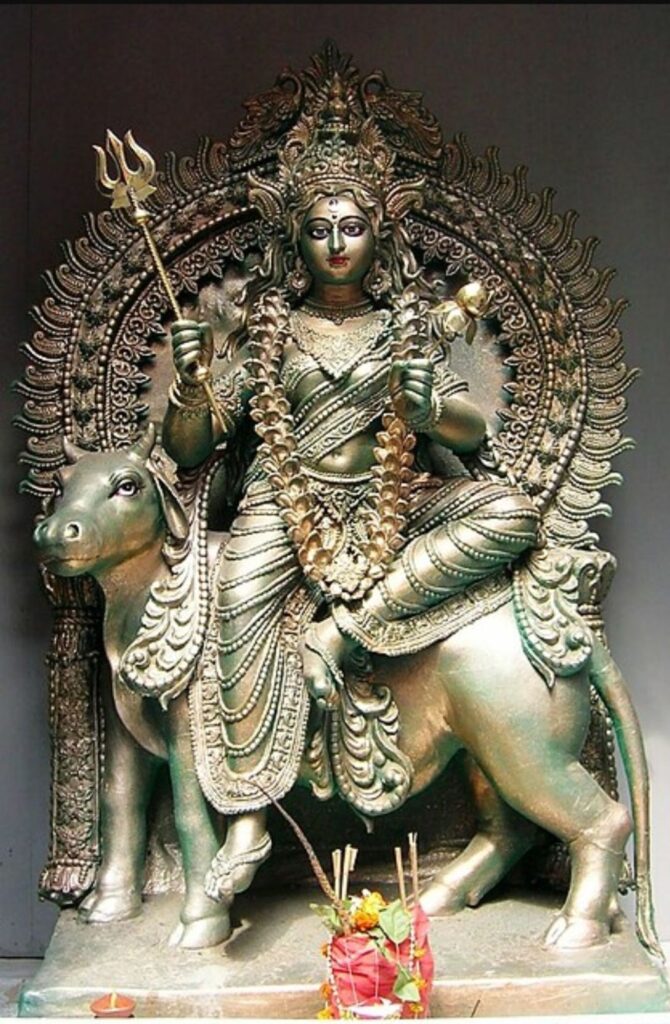
Śailaputrī is the first form amongst Navadurga or the nine forms and is worshipped on the first day during the Navratri celebrations.

The Goddess is depicted having a half moon on her forehead, holding a trident in her right hand and a lotus in her left while riding Nandi, the bull. Her planet is the moon, her favourite flower is the hibiscus and favourite colour is orange. Her other names are Parvati, Bhavani and Hemavati.
Born as the daughter of Himalaya, Śailaputrī literally means daughter (putri) of the mountain (shaila). According to the mythology, Śailaputrī was born in the house of the King of Mountains, Himavat.
In some scriptures like Śiva Purana & Devi-Bhagavata Purana the story of Mother Goddess is written as follow: In her earlier birth, she was born the daughter of Daksha as Sati and was the consort of Lord Śiva. Once Daksha had organized a big Yagna and did not invite Śiva. But Sati being obstinate, reached there. Thereupon Daksha insulted Śiva. Sati could not tolerate the insult of husband and burnt herself in the fire of Yagna. Shiva was devastated when he heard this and went into a state of deep samadhi from which nobody could awaken him. In the meantime, an asura called Taraka had subdued all the worlds and thrown the devas out of their heaven. They went en masse to the presence of Vishnu and begged him to help them. He told them that only the son of Shiva was capable of this. They knew Shiva to be a celibate who had gone into seclusion after Sati’s death. They prayed to Divine Mother Parvati to take another birth to help the world. She was born as the daughter of Himavan. She is the one who is worshipped on the first night of Navaratri as Shailaputri.
Shailaputri is said to be the goddess of the moon. So, any bad effect of the planet moon, can be overcome by worshipping her. Shailaputri is the essence of earthly existence. Her abode is in the very first chakra – the Muladhara Chakra. This chakra is associated with the grossest of the five elements that make up our bodies and the cosmos. This is the tattva or element – Earth. The quality of the earth is coherence and the corresponding guna is that of smell.
Devi Śailaputrī has been considered the embodiment of patience and upon awakening begins her journey from her father to her husband from the Muladhara Chakra or the root chakra which in yogic terms is said to be the base from which the three main psychic channels emerge. Muladhara is considered the foundation of the “energy body” or the “Śakti”.
The ultimate search for her husband requires patience and devotion which Devi Śailaputrī exemplifies. In Navratri pooja, the first day is dedicated to Yogi’s keeping their mind concentrated on Muladhara to generate energy. This is the starting point of their spiritual discipline. They start their sadhana from here.
The shloka describing her form is also given to make it easier for the sadhaka to concentrate on the deity.
“Vande vaanchitalaabhaya chandraardhakrita, shekharam,
Vrishaarudham shuladharaam Shailaputrim yashasvinim.”
I bow to the brilliant Shailaputri, who is adorned with the crescent moon on her head. She rides on the bull, Nandi and holds a trident in one hand and a lotus in the other. May she bestow upon me all the objects of my desire.
Oṁ Devī Śailaputryai Namaḥ! ॐ देवी शैलपुत्र्यै नमः॥